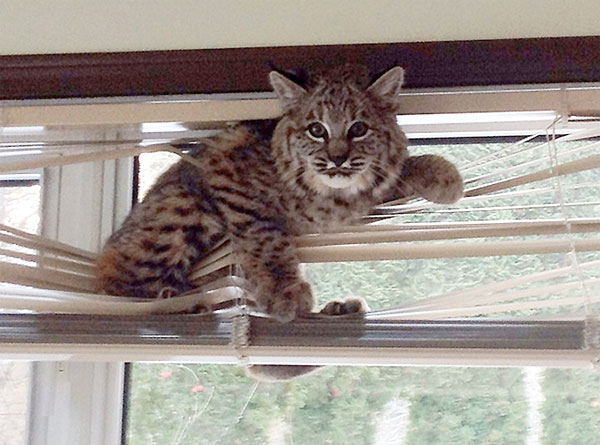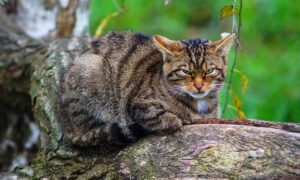This is a wild thing to find in your house — a woman in Nelson, British Columbia came home to find a Bobcat in her basement, which then panicked and tangled itself up in the blinds of a window.

A woman living in Nelson, British Columbia, was quite surprised to come home and find a bobcat in her basement. The poor, confused animal probably got in because a door was blown open while she was out. Once in, though, it couldn’t find a way to get out again, and became agitated, lunging at a window…
“Initially I just saw the front of its face and thought, ‘oh, it’s just someone’s cat,’ but then I saw the rest of it,” Kalabis said.
The animal was about three times the size of a house cat, with the distinctive black-tufted ears and stubby tail that could only belong to a bobcat. Kalabis’ dog, with a slight size advantage, went after the animal.
“They battled it out for a little bit, then the bobcat scaled the wall towards a windows and got into the blinds,” Kalabis said. “It became pretty entangled in the blinds, as it was thrashing and hissing at my dog.”
Sadly, the bobcat couldn’t extricate itself from the blinds…
The woman called the RCMP (police) and a neighbor who MacGyvered a way to free the feline. Using duct tape, they connected two broom sticks together and attached a knife to the end. With this makeshift spear, they cut the animal free from the blinds and shooed it out the door.
[symple_divider style=”solid” margin_top=”20px” margin_bottom=”20px”]
The bobcat (Lynx rufus) is a North American mammal of the cat family Felidae. There are 12 recognized subspecies, it ranges from southern Canada to northern Mexico, including most of the continental United States. The bobcat is an adaptable predator that inhabits wooded areas, as well as semidesert, urban edge, forest edges, and swampland environments. It persists in much of its original range, and populations are healthy.
The bobcat resembles other species of the Lynx genus, but is on average the smallest of the four. Its coat is variable, though generally tan to grayish-brown, with black streaks on the body and dark bars on the forelegs and tail. Its spotted patterning acts as camouflage. The ears are black-tipped and pointed, with short, black tufts. There is generally an off-white color on the lips, chin, and underparts. Bobcats in the desert regions of the southwest have the lightest-colored coats, while those in the northern, forested regions are darkest. Kittens are born well-furred and already have their spots. A few melanistic bobcats have been sighted and captured in Florida. They appear black, but may still exhibit a spot pattern.
 The face appears wide due to ruffs of extended hair beneath the ears. Bobcat eyes are yellow with black pupils. The nose of the bobcat is pinkish-red, and it has a base color of gray or yellowish- or brownish-red on its face, sides, and back. The pupils are round, black circles and will widen during nocturnal activity to maximize light reception. The cat has sharp hearing and vision, and a good sense of smell. It is an excellent climber, and will swim when it needs to, but will normally avoid water.
The face appears wide due to ruffs of extended hair beneath the ears. Bobcat eyes are yellow with black pupils. The nose of the bobcat is pinkish-red, and it has a base color of gray or yellowish- or brownish-red on its face, sides, and back. The pupils are round, black circles and will widen during nocturnal activity to maximize light reception. The cat has sharp hearing and vision, and a good sense of smell. It is an excellent climber, and will swim when it needs to, but will normally avoid water.
The adult bobcat is 47.5 to 125cm (18.7 to 49in) long from the head to the base of the tail, averaging 82.7cm (32.6in); the stubby tail adds 9 to 20cm (3.5 to 7.9in) and its “bobbed” appearance gives the species its name. An adult stands about 30 to 60cm (12 to 24in) at the shoulders. Adult males can range in weight from 6.4 to 18.3kg (14 to 40lb), with an average of 9.6kg (21lb); females at 4 to 15.3kg (8.8 to 34lb), with an average of 6.8kg (15lb). The largest bobcat accurately measured on record weighed 22.2kg (49lb), although unverified reports have them reaching 27kg (60lb). Furthermore, a June 20th, 2012 report of a New Hampshire roadkill specimen listed the animal’s weight at 27kg (60lb). The largest-bodied bobcats are from eastern Canada and northern New England of the subspecies (L. r. gigas), while the smallest are from the southeastern subspecies (L. r. floridanus), particularly those in the southern Appalachians. The bobcat is muscular, and its hind legs are longer than its front legs, giving it a bobbing gait.
Source: Honey, there’s a bobcat stuck in the window…
Bobcat Info: Wikipedia













